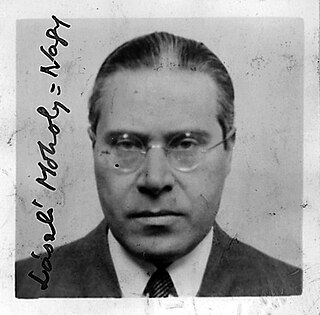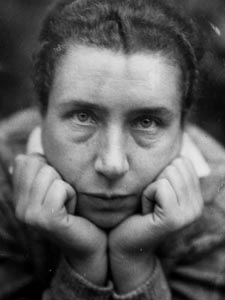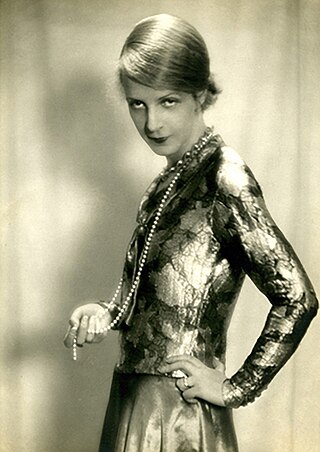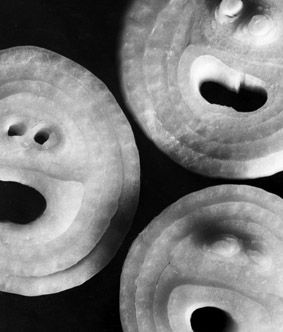
The Staatliches Bauhaus, commonly known as the Bauhaus, was a German art school operational from 1919 to 1933 that combined crafts and the fine arts. The school became famous for its approach to design, which attempted to unify individual artistic vision with the principles of mass production and emphasis on function. Along with the doctrine of functionalism, the Bauhaus initiated the conceptual understanding of architecture and design.
Herbert Bayer was an Austrian and American graphic designer, painter, photographer, sculptor, art director, environmental and interior designer, and architect. He was instrumental in the development of the Atlantic Richfield Company's corporate art collection until his death in 1985.

László Moholy-Nagy was a Hungarian painter and photographer as well as a professor in the Bauhaus school. He was highly influenced by constructivism and a strong advocate of the integration of technology and industry into the arts. The art critic Peter Schjeldahl called him "relentlessly experimental" because of his pioneering work in painting, drawing, photography, collage, sculpture, film, theater, and writing.

Constructivism is an early twentieth-century art movement founded in 1915 by Vladimir Tatlin and Alexander Rodchenko. Abstract and austere, constructivist art aimed to reflect modern industrial society and urban space. The movement rejected decorative stylization in favour of the industrial assemblage of materials. Constructivists were in favour of art for propaganda and social purposes, and were associated with Soviet socialism, the Bolsheviks and the Russian avant-garde.

The Moholy-Nagy University of Art and Design, former Hungarian University of Arts and Design, is located in Budapest, Hungary. Named after László Moholy-Nagy, the university offers programs in art, architecture, designer and visual communication.

Lucia Moholy was a photographer and publications editor. Her photos documented the architecture and products of the Bauhaus, and introduced their ideas to a post-World War II audience. However, Moholy was seldom credited for her work, which was often attributed to her husband László Moholy-Nagy or to Walter Gropius.

Robert Brownjohn was an American graphic designer known for blending formal graphic design concepts with wit and 1960s pop culture. He is best known for his motion picture title sequences, especially From Russia with Love and Goldfinger.

György Kepes was a Hungarian-born painter, photographer, designer, educator, and art theorist. After immigrating to the U.S. in 1937, he taught design at the New Bauhaus in Chicago. In 1967 he founded the Center for Advanced Visual Studies at the Massachusetts Institute of Technology (MIT) where he taught until his retirement in 1974.

Sibyl Moholy-Nagy was an architectural and art historian. Originally a German citizen, she accompanied her second husband, the Hungarian Bauhaus artist László Moholy-Nagy, in his move to the United States. She was the author of a study of his work, Moholy-Nagy: Experiment in Totality, plus several other books on architectural history.

Sidney Jonas Budnick was an American abstract artist. He was born and raised in New York City.
Milton Halberstadt (1919–2000) was a US photographer in fine art and commercial photography who left a body of work covering genres from abstract art to commercial photography.
Nathan Lerner was an American photographer and industrial designer involved in the New Bauhaus.
Franz Altschuler was a German artist and illustrator who drew for Playboy, textbooks and newspapers, but also worked with fine art and drawing. Born in Mannheim, Germany, Altschuler and his family emigrated to the US when he was a teenager. He moved to Chicago in 1946 as a student of the renowned painter, photographer and Bauhaus design professor László Moholy-Nagy at the Illinois Institute of Technology's Institute of Design.

Jay Doblin was an American industrial designer and educator, best known for his contribution to the field of design in particular his work related to systems thinking, design methods and design theory in general. Throughout his professional career he worked with some of the most important design firms of their time, including Raymond Loewy Associates, Lippincott & Margulies, and Unimark International, which he founded together with Massimo Vignelli and Bob Noorda.

The Neues Sehen, also known as New Vision or Neue Optik, was a movement, not specifically restricted to photography, which was developed in the 1920s. The movement was directly related to the principles of the Bauhaus. Neues Sehen considered photography to be an autonomous artistic practice with its own laws of composition and lighting, through which the lens of the camera becomes a second eye for looking at the world. This way of seeing was based on the use of unexpected framings, the search for contrast in form and light, the use of high and low camera angles, etc. The movement was contemporary with New Objectivity with which it shared a defence of photography as a specific medium of artistic expression, although Neues Sehen favoured experimentation and the use of technical means in photographic expression.

The Bauhaus was seen as a progressive academic institution, as it declared equality between the sexes and accepted both male and female students into its programs. During a time when women were denied admittance to formal art academies, the Bauhaus provided them with an unprecedented level of opportunity for both education and artistic development, though generally only in weaving and other fields considered at the time to be appropriate for women.

Alysa Nahmias is an American filmmaker and the founder of Ajna Films.
Arthur Sidney Siegel was an American photographer and educator.

900 910 North Lake Shore are a pair of glass and steel buildings, perpendicular to one another, designed by architect Ludwig Mies van der Rohe, in the Streeterville neighborhood of Chicago. Completed in 1956, they marked the refinement of Mies' highrise building design concept. The buildings are built to a Modernist International style that was considered to be a departure from the dominant aesthetic at the time they were built, and even criticized as too minimal. The "glass houses" are more often appreciated for the views they offer of Lake Michigan and downtown Chicago. The buildings were referred to as “giant mirrors for lake beauty”.
Bauhaus was a quarterly avant-garde art and design magazine which existed in the period between 1926 and 1931 with some interruptions. It was launched by a German art movement with the same name and financed by an art group called Kreis der Freunde des Bauhauses. It had significant effects on the Danish art magazines such as Kritisk Revy and Linien.













